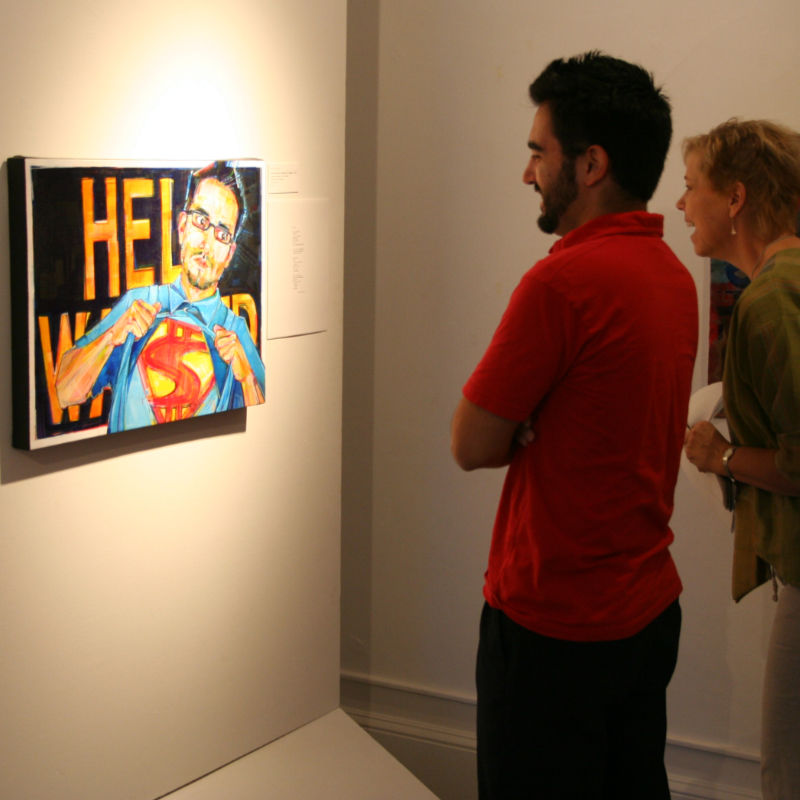Blog / 2017 / Among the Living and the Dead
July 11, 2017
Back in 2008, in Portland, Oregon, I was 27 and preparing my eighth series of paintings, portraits of mostly first and second generation Americans that I called Apple Pie.

For the first time, I was putting together an exhibition catalog to go along with a body of work, and I knew I needed someone to write an introduction. The only person who made any sense to me was Inara Verzemnieks.
Nine years later, the same Inara would write a book called Among the Living and the Dead, which is officially released today! It tells of those nine years and of many years before as well. It tells of Inara’s visits to Latvia, where, through her cousins who had stayed in the old country, she came to understand her American family better.
But, back in 2008, Inara hadn’t been to Latvia yet. She lived in the City of Roses like me, and she’d been reporting for The Oregonian for years. She had made a name for herself as a writer who recognized the emotional nuances of a story and shared them artfully with her readers. She’d done an article about my last series of portraits for the paper, and, as the child of an immigrant, she was certainly qualified to be a part of Apple Pie.
I’ve had the pleasure of commissioning a handful of artworks over the years, but this essay, which I’m publishing for the first time on the web, remains my favorite. Like all the art I love most, Inara’s words help me to understand the world better—both the parts I’ve never experienced for myself as well as the parts I have and should already understand but can’t fully without the help of an artist’s perspective.
Do You Consider Yourself an American?
I’m sitting at Gwenn Seemel’s kitchen table, nursing a cup of tea. She’s just found out that my father is Latvian and the next thing I know, her attention is completely trained on me. Never mind that I’m the one who is supposed to be doing the questioning; I’ve come to do a story about Gwenn and her work, but somehow she has managed to turn the conversation around to my life.
Yet this is exactly what intrigues me about Gwenn’s portraits, the way they are built around people’s stories. The way she asks all her subjects detailed questions about their lives and then takes everything she’s seen and heard, the whole crazy swirl of it, and somehow pulls it into focus—transforms the chaos in our heads, our mixed-up patchwork vision of ourselves into something not only recognizable, but revealing.
This is what a good portrait does, offers us a clear, unblinking view of who we are, at this point and time in our lives. And as I think about it now this is really what Gwenn was asking me that day: Who are you? That’s a provocative question, one that we are seldom invited to answer, at least in the spirit of genuine curiosity. And it’s clear that Gwenn is genuinely curious, that she sees the portrait-making process as a good way to come to some kind of answer to this larger question—who are you?—not only for her sitters, but also for herself. “Someone inevitably has an answer I didn’t even realize I needed,” she tells me.
I stumbled through my answer that day. Part of the reason, I think, is that for a long time, I saw my family’s history in terms of loss.
That’s one of the things that happens when you are an immigrant’s child—you can’t help but live with a heightened sense of what’s missing, of what was left behind. And it’s hard to define yourself according to what isn’t there. But I have learned that sometimes we are as much the inheritors of what our parents and grandparents have sacrificed as what they kept.
This is something I think about every time I look at my grandparent’s portraits.
Not long after I took my first job, I framed a copy of my grandparents’ passport photos and hung it near my desk, a visual reminder of all that they had given up so that I might be sitting here now. My grandparents—along with my father and his three siblings—had come to the United States in 1951 as refugees from Latvia, which after WWII, fell under Soviet occupation. There is no point going into thousands of years of history, but it’s enough to say this was not the first time Russians had occupied Latvia and many people—my grandparents included—had only painful, bloody memories of those days, and they wished to spare their children the same. They spent nearly seven years in a refugee camp in Germany, before finally receiving sponsorship to America.
My grandparents were in their 30s at the time and often, I have found myself studying those passport portraits, trying to get inside their heads. They were about to leave behind careers, family, friends—all they’d known—for a place they’d never seen.
What did they imagine their American life would look like? Did they imagine it at all?
Their faces never tell me, although I like to think I see what looks like hope.
As it was, they settled in Tacoma in a broken-down apartment building, my grandfather, an economics professor in Latvia, trading his textbooks for roofers’ tar. My dad, 6 at the time, trooped off to elementary school, where an older boy cornered him in the bathroom, and, for reasons my dad couldn’t fully understand because he spoke no English, punched him in the stomach so violently my dad passed out.
And that’s how it goes when you’re trying to make sense of chaos, when you’re trying to fashion an ordinary life from the most extraordinary circumstances (sudden disassociation, sensory overload, confusion—a journey the author Junot Diaz has said is as strange and upending as time-travel): You learn to get used to the moments of overwhelming blackness, the stars breaking behind your eyes.
Eventually you come to, and before you know it, you’re wearing jeans and hanging out at the drive-in and eating burgers and insisting everyone call you George (the closest American equivalent to your name, the one with the tricky J that you say like a Y, soft and longing—Juris—not Juris, as though you are some strange approximation of “jurist,” although in a way you are: judging, watching, deciding who you want to be; that is both the immigrantvs blessing and curse. You get to decide who you want to be.)
Strange fusions develop. Of what must be embraced and what can’t be let go.
My grandmother learns to make meatloaf in the same kitchen where she bakes the saffron-flavored braided bread that is the hallmark of all Latvian celebrations. My grandfather learns to peck out letters-to-the-editor on the same old Olympia typewriter that he uses to write bulletins for the Latvian Evangelical Lutheran Church. (He learns to draw in the diacritical marks of his native tongue with a pen.) They buy only Chrysler K-cars, which they then use to drive to weekly choir practices where my grandmother sings the hymns and folk songs of home.
My dad decides he is Juris again, but my uncle Janis becomes just John. When my aunt Maruta dies in her 30s, she is buried at a cemetery in Tacoma that was first opened in 1875 to hold the remains of American pioneers—but according to the traditions of a country she left when she was a little over a year old. The men take turns filling in her grave themselves with shovels, while everyone else stands at the edge, dipping their hands into a metal coffee can and scattering clumps of soil that someone has managed to bring back from still-Communist Latvia.
This is what I come squalling into, the first generation born in America, heir to what has been both lost and found. If my father and his family learned to occupy a space that is neither quite here nor there, then I am both here and there, like the mingling of soils in my aunt’s grave.
And yet, “there” is a place I have never been—at least physically, anyway. (Remember what I said about time travel?) Latvia exists for me only through stories, through the taste of my grandmother’s food, a last name that no one can pronounce. There is Latvian school on the weekends and Latvian camp in the summer where the children and grandchildren of the refugees go off to a patch of land in the woods of Washington for two weeks (a real estate transaction within the refugees’ reach only because the land, while beautiful, is located just down the road from a state correctional institute).
For two weeks we wear folk costumes and learn traditional folk dances and weave bookmarks in the colors of the Latvian flag that we raise each morning while solemnly singing the national anthem (which, we are reminded, the Soviets no longer allow the Latvians back home to sing). If an adult catches you speaking English they can order you to do 10 push-ups on the spot, and we all live in fear of being called out like this, of ending up face-down in the dirt.
Each night, around the dying campfire, clad in our Nikes and OP shorts and smelling of bug spray, we clasp hands and sway and sing a sad, slow folk song begging the wind to blow us back to the Latvian region of Kurzeme. I still think it is one of the most beautiful songs I know. But lying in our bunk beds in the dormitories built to look like traditional houses of the Latvian countryside, the language we whisper to each other is English. Always there is one girl who answers back in Latvian and at first I resent her for this. Why must she be so perfect?
Every year, on the last day of camp, as our parents and grandparents look on, a special award is presented to the girl and boy who are “Most Latvian.” Sometimes it is a necklace, which the camp director, through her tears, clasps around the winners’ necks. I never tell anyone, but each time I fantasize that it will be my name that is called. And for a time, I really believe it is possible. I fall in love with a boy from camp named Karlis who sends me a book of Latvian poetry. We speak only Latvian to each other. I tell my girlfriends that if I ever marry, I only want to marry another Latvian. I beg my parents to buy me a Latvian ring for my 16th birthday—the kind once traditionally given to mark an engagement, now the preferred adornment of choice among those Most Likely To Be Most Latvian.
I try my hardest. But the truth is that my Latvian is too accented, split between life with my dad’s family—six years spent with my grandparents, following my parents’ divorce—and weekends at my American mother’s. I need a dictionary to understand even a line of the love poetry. My ring breaks. I never have another Latvian boyfriend after Karlis. I stopped feeling guilty about this a long time ago. In fact I’ve come to recognize that this is the beauty of my story. This is who I am.
I used to think I had to choose. I realize now that a part of me had been afraid of adding to my family’s loss. Knowing all theyvd given up, I wanted to try and get it back somehow. But I had been framing it all wrong. My grandparents understood this long before I did.
Late in their lives, after Latvia declared its independence from the Soviet Union, they returned, with my father, for the first time in 41 years. They visited all the places of their youth, the boarding school where they met, the apartment they shared in Riga as newlyweds, the cobblestone streets where they walked hand-in-hand to the opera. They also spent several days at the farm where my grandmother grew up. Relatives had rescued it from neglect and started working the land again. My dad told me years later that my grandmother spent many hours off on her own, walking the fields, retracing the paths she had taken as a girl. So I think it surprised us all a bit that they never went back. Many of their friends were visiting regularly, buying property, re-establishing roots. Why? My grandmother said. This is home.
When they died, we buried my grandparents in that Tacoma cemetery, originally meant for the pioneers. We threw in handfuls of soil from Latvia. But I also brought some dirt from my grandparents’ garden, carefully excavated from the patch of calla lilies my grandmother raised near the back porch of the house where she and my grandfather spent the last 50 years of their lives, raising their children, then me. The place they called home. I threw it all in, watched it tumble and mix.
This is my answer to Gwenn’s question, everything I wish I would have said that day in the kitchen over tea. But I just couldn’t see it then, not yet. Not until she gave me a framework.
I understand now that my family’s history—the histories of all immigrants, of the first and second generations—is not so much about loss, but about transformation. Taking the sadness and chaos and uncertainty of what happened to you—all these jumbled, disparate parts—and transforming it into something else. Something funny, something strange, something new.
Something beautiful.
This is why I tell you this story.
This is my portrait.Maybe this post made you think of something you want to share with me? Or perhaps you have a question about my art? I’d love to hear from you!
To receive an email every time I publish a new article or video, sign up for my special mailing list.
If you enjoyed this post, Ko-fi allows you to donate. Every dollar you give is worth a bajillion to me!



